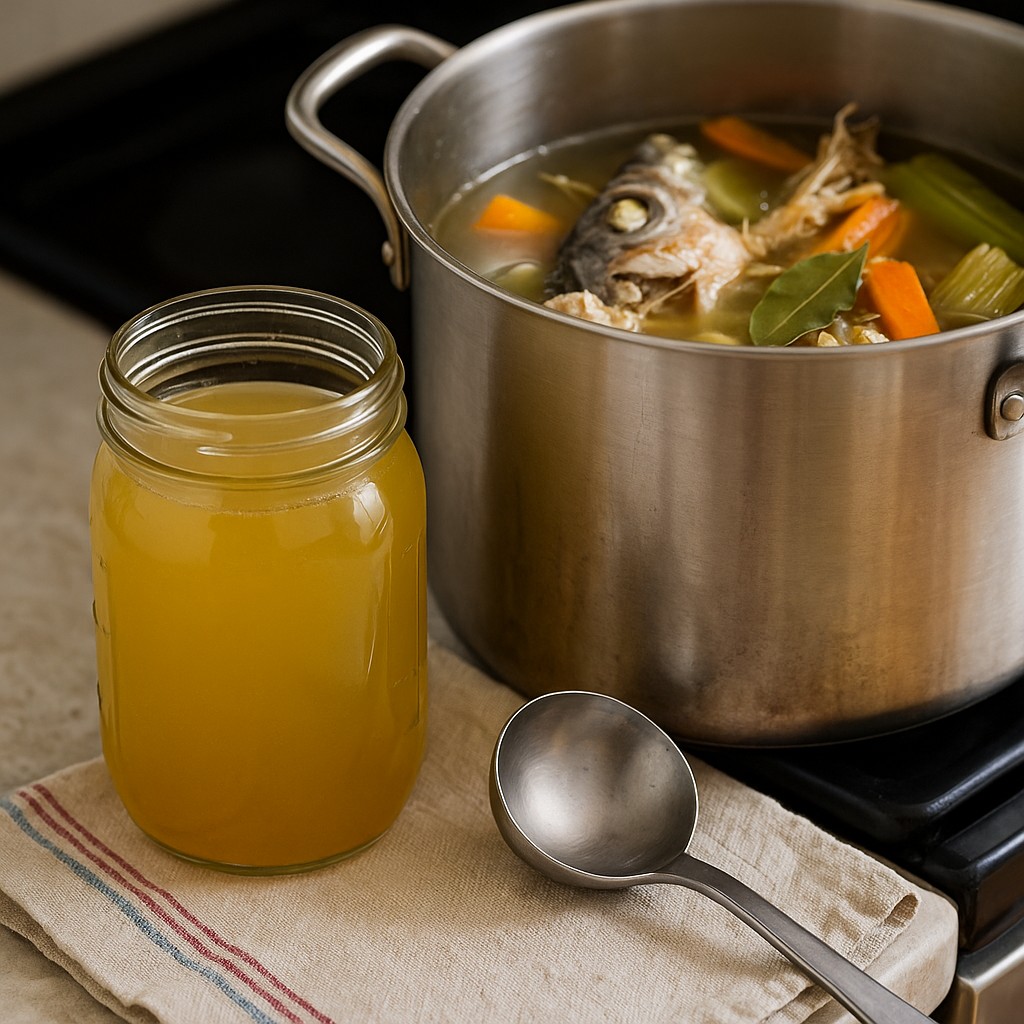Check this out!
Homemade fish stock is one of the most versatile bases you can keep in your pantry. Unlike meat-based stock, fish stock has a lighter body with delicate flavor that enhances seafood chowders, risottos, soups, and sauces without overpowering them. By pressure canning fish stock, you can capture its freshness and store it safely for future meals, ensuring you always have a nutrient-rich, flavorful base ready to use. This recipe walks you through the vital steps for preparing and preserving fish stock using bones, heads, and trimmings to maximize both flavor and sustainability.
I sometimes use affiliate links in my content. This will not cost you anything but it helps me offset my costs to keep creating new canning recipes. Thank you for your support.
By Diane Devereaux, The Canning Diva®
Last updated: October 1, 2025
Key Takeaways
- Fish stock creates a delicate, lighter base compared to meat-based stock, making it ideal for seafood chowders, risottos, and sauces.
- Pressure canning preserves fish stock safely for long-term storage, ensuring you always have a seafood base ready at your fingertips.
- Making stock from fish bones, heads, and trimmings reduces waste and maximizes flavor, turning leftovers into a valuable kitchen staple.
- Fish stock is versatile in global cuisines, from French bouillabaisse to Japanese ramen broths, proving its importance beyond just one culture.
Story and Background of Fish Stock
For centuries, cultures across the world have valued fish stock as the foundation of seafood cooking. In France, it’s the key to classic dishes like bouillabaisse and bisque, where the stock provides both depth and refinement. In Japan, a variation of fish stock is used in ramen and miso soup, giving those dishes their signature umami richness. Even Nordic traditions highlight fish stock as a base for creamy chowders that fuel cold-weather communities along the sea.

Culinarily, fish stock offers something unique compared to meat-based stock: it carries a clean, delicate flavor that enhances seafood without overwhelming it. Unlike beef or chicken stock, fish stock doesn’t gel as firmly when cooled because fish bones contain less collagen, but this lighter texture is exactly what makes it ideal for seafood dishes. By simmering fish bones, heads, and trimmings with aromatic vegetables and herbs, you not only extract flavor but also create a sustainable way to use every part of the fish.
When preserved through pressure canning, fish stock becomes a shelf-stable pantry essential. It gives home cooks the ability to prepare restaurant-quality seafood meals year-round, with the added assurance that nothing goes to waste.
Saving Bones and Shells for Fish Stock
Homemade stock is one of the best ways to stretch your grocery budget and make use of ingredients that might otherwise be discarded. Instead of throwing away fish heads, shrimp shells, or vegetable trimmings, you can save them in the freezer until you’re ready to make a batch of stock. This approach not only reduces food waste but also ensures your stock is rich with flavor and nutrients.
Here is a list of the various types of bones, shells, and vegetable scraps you can collect and store in the freezer over time to create a delicious fish or shellfish stock.
Fish Bones and Parts
- Fish heads (non-oily, white-fleshed fish are best: cod, snapper, halibut, sole, tilapia)
- Fish frames (the skeleton with ribs attached)
- Tails and fins
- Fish skin (well-scaled and cleaned)
Note: Avoid oily fish such as salmon, bluefish, or mackerel unless you want a very strong fish flavor.
Shellfish By-Products
- Shrimp shells and heads
- Crab shells
- Lobster shells
- Crawfish shells
Vegetable and Herb Scraps
- Onion ends and peels
- Celery ends and leaves
- Carrot ends and peels
- Leek or fennel tops
- Parsley stems and herb stalks
These can all be stored in gallon freezer bags, flattened for easy stacking. When you’ve collected enough (about 5 pounds of fish parts or 1–2 bags of shells), you’re ready to make a pot of stock.
Fish Stock Recipe for Home Canning
Use this stock to create the perfect base for clam chowder or seafood stew. It’s a wonderful addition to seafood risotto and shrimp and fish étouffée—essentially any dish calling for seafood. This is the perfect canning recipe to create stock after cleaning your fresh catch and canning filets.
Make approx. 4 quarts or 8 pints
Ingredients
- ¼ cup olive oil
- 4 medium onions, diced (2 cups)
- 6 garlic cloves, smashed
- 8 celery stalks, chopped (4 cups)
- 8 large carrots, peeled and finely diced (4 cups)
- 1 bunch fresh thyme
- ½ bunch fresh parsley
- 8 pounds fish bones, heads, fins, ribs, and tails
- 1 cup dry white wine
- 16 cups boiling water
- 2 bay leaves
- 1 tablespoon whole peppercorns
Instructions
- In a 12- or 16-quart stockpot, add the oil, onions, garlic, celery, carrots, thyme, and parsley. On medium-high heat, sauté until the onions are translucent, about 5 to 8 minutes. Cover the bottom of the stockpot evenly with the mixture.
- Cover the onion mixture in the stockpot with the fish parts. Pour in the wine, cover the pot with a lid and let the fish bones sweat for 20 minutes.
- Add the boiling water, bay leaves, and peppercorns and return to a boil using high heat. Reduce the heat and simmer, uncovered, for 30 minutes.
- Throughout the simmering process, skim off foam and discard. Do not disturb the stock.
- Using a slotted spoon, remove the fish parts, vegetables, and herbs from the stockpot and discard. Pour the stock through a fine-mesh chinois strainer or sieve, capturing the strained stock in a large, clean stockpot.
- Line a strainer with dampened cheesecloth, and strain again, slowly, capturing the strained stock in a large, clean pot.
- Ladle the hot strained stock into hot jars, leaving 1 inch of headspace.
- Wipe the rim of each jar with a warm washcloth dipped in distilled white vinegar. Place a lid and ring on each jar and hand tighten.
- Process in a pressure canner at 10 PSI or according to your elevation and canner type. Quarts process for 90 minutes and pints process for 70 minutes.
People Often Ask
A: It’s best to use white, non-oily fish like cod, halibut, snapper, tilapia, or sole. Oily fish such as salmon, mackerel, or bluefish create an overpowering flavor and often leave the stock with an unpleasant, strong aftertaste.
A: Save fish heads, frames (skeletons with ribs), tails, fins, shrimp shells and heads, and lobster, crab, or crawfish shells. Keep them in freezer bags or containers until you’ve collected enough to make a batch.
A: Avoid oily fish parts (like salmon heads and skins), organs, and overly strong vegetable scraps such as potato peels, kale stems, or broccoli trimmings. These can cloud the stock and negatively impact the flavor.
A: Not usually. Fish bones contain less collagen, so fish stock tends to remain more liquid when cooled and stored. This lighter texture is ideal for seafood chowders, bisques, and risottos where a delicate base is preferred.
About the Author:
Diane Devereaux, The Canning Diva®, is an internationally recognized food preservation expert, author, and educator with over 30 years of home canning experience. She’s the author of multiple top-selling canning books and teaches workshops across the U.S. Learn more at TheCanningDiva.com.

